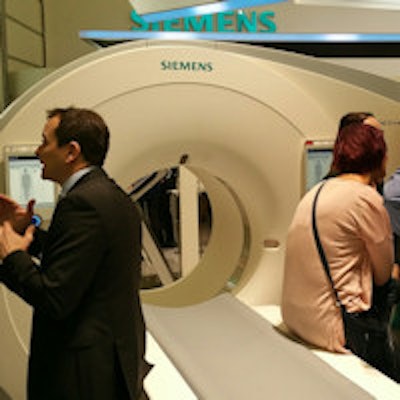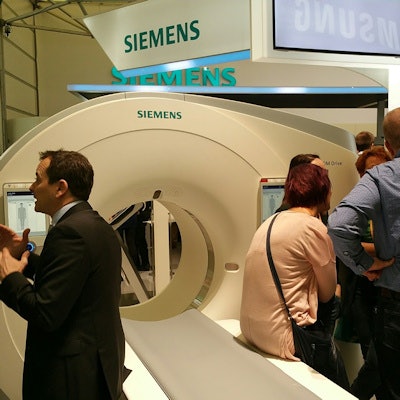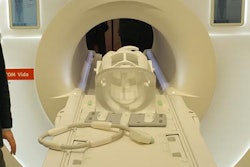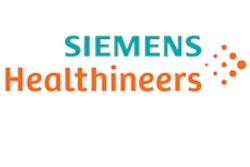
VIENNA - A new high-end offering in its dual-source CT product line -- called Somatom Drive -- is the focus of Siemens Healthcare at this week's ECR 2016 meeting.
Somatom Drive represents a new segment in the company's family of dual-source CT offerings, occupying a price point between the super-premium Somatom Force and the Somatom Flash, an entry-level dual-source scanner. The new system is designed to offer many of the powerful imaging capabilities of Force, such as dual-energy imaging, but in a package that's more focused on clinical use rather than research.
Siemens believes that Drive will prove particularly useful in areas such as pediatric imaging and the emergency department, where its low radiation dose and quick scanning speed will confer benefits. The scanner is designed to support personalized imaging, such as by setting automated protocols based on a combination of the clinical environment and a topogram of the patient.
 Somatom Drive occupies the midrange price point in Siemens' dual-source CT portfolio.
Somatom Drive occupies the midrange price point in Siemens' dual-source CT portfolio.The scanner is automatically set to scan pediatric patients at 70 kV, for lower radiation dose, and energy levels can be adjusted in 10-kV steps for additional flexibility.
Drive differs from Force in that it has slightly narrower detectors than the super-premium scanner, and Drive has a 0.28-second gantry rotation speed, compared with 0.25 seconds for Force. Siemens plans to launch Drive in Europe as well as the U.S. this summer, after the system receives appropriate regulatory clearances.
Also in its ECR booth, Siemens is promoting syngo.via Frontier, a cloud-based collaboration environment designed to make it easier for researchers to develop advanced image postprocessing apps. Users of Frontier start by downloading a software development kit (SDK) that will enable them to develop prototype apps based on CT and MR clinical images that they can access through the service.
Users can collaborate with other researchers in developing their apps, and once they are complete, they can upload them into an app store environment where they can be downloaded by other Frontier users for research applications. Sample MRI apps that are available now in the store include MRI body diffusion, MR elastography registration, and MR track density imaging (TDI). Siemens is highlighting CT and MR images processed with a cinematic rendering protocol available through Frontier that creates images of photorealistic quality.
Also in MRI, Siemens is discussing Simultaneous Multi-Slice, an application that reduces the time needed for neurological MRI exams. The technique uses a special protocol to acquire image slices simultaneously rather than sequentially, reducing acquisition time by up to 68% for diffusion tensor imaging (DTI) exams.
Another MRI application, GoBrain, is designed to allow users to create clinically validated "push-button" brain exams in five minutes. The company plans to introduce other push-button applications for other anatomic regions.
In other Siemens ECR 2016 news, the company is promoting Multitom Rax, a robotic x-ray system introduced in late 2015. Rax performs classic 2D x-ray, as well as fluoroscopy procedures, angiography applications, and 3D CT imaging. Its robotic arms allow the tube and detector to be positioned precisely, eliminating the need to readjust the patient between different exams or to change rooms.
In its ECR booth, Siemens is highlighting Rax's capability to acquire 3D images with patients in weight-bearing positions, either sitting, lying down, or standing. The company believes weight-bearing images can help physicians better diagnose patients and plan therapy.
In women's imaging, Siemens is introducing new visualization modes for digital breast tomosynthesis (DBT). One new mode, called Empire (enhanced multiple parameter iterative reconstruction), allows tomo slices to be reconstructed more precisely with new algorithms, sharpening images and enabling microcalcifications to be identified more clearly.
Another new mode, Insight 2D, enables the software-based generation of 2D tomo images, obviating the need for a conventional mammography image to accompany the tomo study. Meanwhile, Insight 3D is a tomo mode with a 50° scan angle and high-definition DBT images. Empire, Insight 2D, and Insight 3D are being developed and are not currently available, according to the company.
Other Siemens ECR 2016 highlights include the Biograph Horizon PET/CT system with lutetium oxyorthosilicate (LSO) detector crystals, while in ultrasound the Acuson S and Helx Evolution with Touch Control systems are being emphasized. Meanwhile, the Acuson NX3 and Acuson NX3 Elite scanners are designed to support faster workflow with fewer keystrokes.
In angiography, Siemens has added two new features to its Pure platform for the Artis zee, Artis Q, and Artis Q.zen angiography systems. Syngo EVAR Guidance is designed to support endovascular aneurysm repair (EVAR), while syngo CT Guidance automatically segments coronary CT angiography images in addition to providing procedural guidance.



















